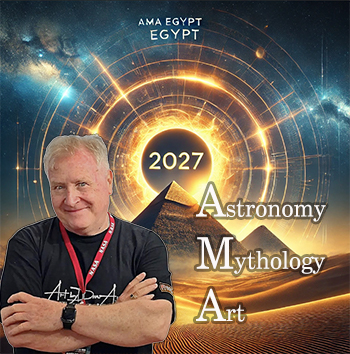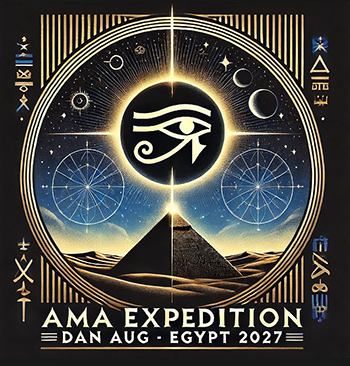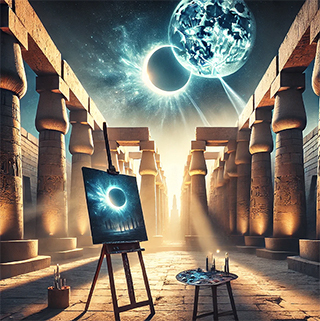AMA Expedition - Dan Aug Egypt 2027
Daniel Augusto Chiesa (DAN AUG)
In 2027, Luxor, Egypt will witness a rare and spectacular astronomical event: a total solar eclipse. This celestial phenomenon will provide an extraordinary backdrop for the AMA expedition, deepening the exploration of the interplay between art, mythology, and astronomy in Luxor’s sacred landscape. Luxor, the ancient city of Thebes, stands as an unparalleled repository of human history, particularly regarding the religious, artistic, and astronomical advancements of ancient Egyptian civilization. As a profound admirer of the ancient Egyptian Civilization, I recognize the immense value of the AMA expedition in documenting how ancient Egyptians integrated these domains into a cohesive worldview. The alignment of temples such as Karnak with celestial events, the intricate representations of the cosmos in tombs, and the mythological narratives carved into the stone walls are all vital aspects of understanding the intellectual achievements of the ancients. This expedition, led by Dan Aug, promises to bring forth new perspectives on their sophisticated cosmology and its implications for contemporary studies.

ASTRONOMIC EVENT IN EGYPT
Astronomy has always been central to ancient Egyptian thought, influencing their architectural alignments, religious beliefs, and even governance. The total solar eclipse of 2027 in Egypt adds a remarkable layer to this exploration, mirroring the celestial observations of the ancients. I see Luxor as one of the most significant sites for understanding how early civilizations conceptualized the universe. The AMA expedition provides a crucial opportunity to study the astronomical alignments of the temples and to analyze how the ancients integrated celestial cycles into their mythology and daily lives. The ancient Egyptians’ comprehension of stellar movements and their connection to deities such as Osiris (associated with the Orion constellation) and Nut (the sky goddess) speaks to their advanced observational capabilities. By revisiting these alignments with modern astronomical tools and artistic interpretation, the AMA expedition will deepen our appreciation of the sophisticated cosmological framework that underpinned ancient Egyptian civilization.

ANCIENT .EGYPT .MYSTICISM
Beyond academic and artistic considerations, Luxor is a spiritual gateway, a place where the energy of the ancients still resonates. The total solar eclipse of 2027 will be a moment of great spiritual significance, mirroring the celestial cycles that were so deeply embedded in ancient Egyptian rituals and beliefs. The temples and tombs of this sacred city serve as conduits for higher consciousness, encoded with symbolic wisdom meant to transcend time. As a specialist in ancient Egyptian mysticism, I view the AMA expedition as an essential undertaking to reconnect with the esoteric traditions that governed the spiritual lives of the ancient people of Kemet. The sacred geometry embedded in the architecture, the ritualistic alignment with cosmic forces, and the initiatory knowledge preserved in hieroglyphic texts are invaluable for those seeking to understand the metaphysical dimensions of human existence. By engaging with these ancient sites through a mystical and artistic lens, Dan Aug’s expedition will facilitate a profound dialogue between past and present seekers of knowledge, offering a transformative experience for those involved

AMA EXPEDITION: ART PERSPECTIVE
From the perspective of a contemporary art curator and collector, the AMA expedition represents an extraordinary opportunity to bridge the past and the present through artistic exploration. The visual language of ancient Egypt has inspired generations of modern and contemporary artists, and Dan Aug’s artistic vision is poised to extend this tradition in an innovative and thought-provoking manner. His ability to reinterpret historical motifs with contemporary mediums provides a unique lens through which to appreciate Egypt’s artistic legacy. By engaging directly with Luxor’s monumental art and integrating it into new creative expressions, this expedition will not only pay homage to the past but also inspire future generations of artists and collectors alike. The documentation and reinterpretation of these ancient masterpieces will foster a deeper appreciation for Egypt’s enduring artistic influence on modern aesthetics involved

WHY SUPPORT "AMA EXPEDITION" ?
The AMA Expedition to Luxor in 2027 is a groundbreaking interdisciplinary project that unites art, mythology, and astronomy in a way that has never been done before. It will:
# Contribute to the academic field by offering new insights into the intersections of Egyptian mythology and astronomical knowledge.
#Inspire contemporary artists and collectors by fostering a renewed appreciation for ancient Egyptian aesthetics and their modern interpretations.
#Enhance our understanding of ancient celestial observations and how they influenced temple alignments and religious practices.
#Provide a rare opportunity for spiritual exploration, enabling participants to connect with the profound mystical traditions of Luxor.
Dan Aug’s vision for the AMA expedition aligns with the highest aspirations of scholars, artists, scientists, and mystics alike. This initiative deserves full support from academic institutions, art foundations, collectors, and those interested in the spiritual heritage of ancient Egypt. By funding and promoting this expedition, we ensure that the legacy of Luxor continues to inspire new generations, bridging millennia of knowledge, creativity, and cosmic wonder. perspective of a contemporary art curator and collector, the AMA expedition represents an extraordinary opportunity to bridge the past and the present through artistic exploration. The visual language of ancient Egyp
